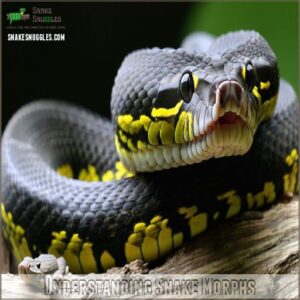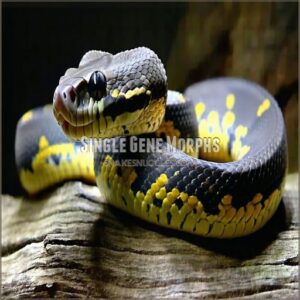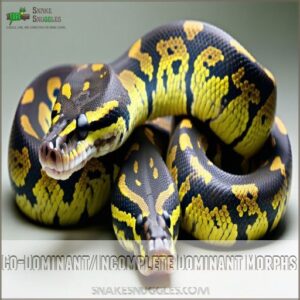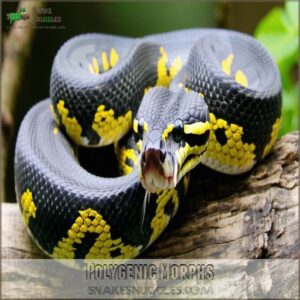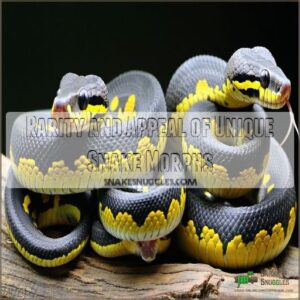This site is supported by our readers. We may earn a commission, at no cost to you, if you purchase through links.
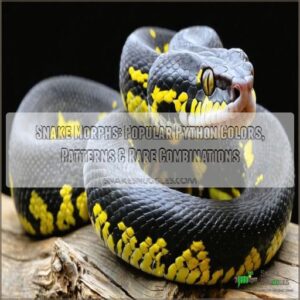
Some, like Albino morphs, flaunt white-and-yellow scales with striking red eyes, while Piebald morphs surprise you with unpredictable white patches.
Morphs are created through genetic traits—single gene morphs like Pastels are easy to breed, while polygenic morphs craft complex designs.
Rare finds like the Blue-Eyed Leucistic are highly coveted, blending scarcity with beauty.
Whether you love vivid bananas or grayscale masterpieces, morphs transform snakes into living art. Ready to see what breeders dream up next?
Table Of Contents
- Key Takeaways
- Understanding Snake Morphs
- Types of Ball Python Morphs
- Popular Ball Python Morphs in The Market
- Rarity and Appeal of Unique Snake Morphs
- Creating Visual Interest With Morph Combinations
- Frequently Asked Questions (FAQs)
- What are morphs in snakes?
- What is the rarest python morph?
- Are reptile morphs inbred?
- What is the most popular ball python morph?
- What is the rarest snake morph?
- What is the prettiest ball python morph?
- What are the 3 types of snakes?
- Do morphs affect snake behaviour?
- Are snake morph mutations ever isolated?
- Whats the priciest morph?
- Conclusion
Key Takeaways
- You’ll find ball python morphs are genetic mutations that create stunning colors and patterns, turning snakes into living art.
- Rare morphs like Blue-Eyed Leucistics or Sunset Dreamsicles are highly sought after for their beauty and scarcity.
- Breeding strategies, including ethical practices, are crucial for creating visually captivating snakes while ensuring their health.
- Popular morphs, such as Banana and Albino, combine vibrant visuals with affordability, making them favorites among reptile enthusiasts.
Understanding Snake Morphs
Snake morphs are like nature’s living art, showcasing stunning variations in color and pattern through genetic mutations.
With ball python genetics, breeders mix and match traits to create extraordinary combinations.
Think of morphs like designer clothing for snakes—some are classic, like the Albino morph, and others are bold, cutting-edge creations that fetch high prices.
At the core of snake genetics is breeding, pairing snakes strategically to bring out visual impact, from dazzling colors to mesmerizing patterns.
Ethical breeding practices safeguard the health of these snakes while keeping the morph market thriving.
Whether you’re drawn to affordable morphs or dreaming of those rare gems, ball python morphs promise endless fascination, and innovative future trends keep pushing genetic boundaries.
Types of Ball Python Morphs
In the world of Ball Python morphs, you’ll find an incredible variety of colors, patterns, and traits.
All thanks to genetics.
Each type, from single gene morphs to complex combinations, adds its own unique twist to these fascinating snakes.
Single Gene Morphs
Understanding the magic of single gene morphs is like holding the keys to a treasure chest of vibrant snake genetics. These foundational mutations are straightforward yet incredibly impactful, working as either dominant traits or recessive traits to bring out stunning colors and patterns. Here’s the beauty of it: single gene morphs only need one gene copy for their gene expression to shine through, making them predictable and highly sought after, especially for breeding.
If you’re into ball python genetics or exploring snake morphs in general, single gene expression patterns such as those explained in Ball Python Morphs are where the action begins. They’re the blueprint you use to build even more jaw-dropping combinations. For instance, imagine the vibrant yellow of a banana morph or the striking contrasts of an albino morph with its orange-yellow body and piercing pink-red eyes. These aren’t just snakes—they’re like living pieces of art!
What makes single gene morphs exciting is their sheer variety and availability in the market. You can snag a pastel morph, which enhances yellows and makes other patterns pop, or opt for the spider morph, flaunting its breathtaking web-like designs. The choices? Pretty much endless.
Want to spot a single gene morph quickly? Here’s what to look for:
- Bright, consistent colorations like the yellow in pastels or albinos.
- Unique patterns, such as the web-like designs found in spider morphs.
- Eye-catching highlights like intense pigmentation in gene expression.
- Price accessibility—most single gene morphs are budget-friendly.
- Breeding potential as base genes for complex morphs.
If you’re ready to get started, single gene morphs are the perfect gateway to snake genetics mastery!
Co-Dominant/Incomplete Dominant Morphs
Some of the most fascinating aspects of ball python morphs come from codominant and incomplete dominant traits. These genes pack a punch, influencing a python’s look in ways that can’t go unnoticed. Let’s break it down.
Codominant traits, like Mojave or Pastel, show their flair even in the heterozygous state—you only need one copy of the gene to see striking changes in your snake. Think of it like adding a splash of vibrant paint to a blank canvas; the result is immediate and unique.
Incomplete dominant traits, on the other hand, create a more subtle change when heterozygous but go full tilt in their “super” forms when two copies of the gene are present. That’s when things like bright contrasting colors or amplified patterns take center stage.
The real magic? Mixing traits. Gene interactions open up endless combinations.
- Super forms shine: Double doses of a gene amplify traits.
- Heterozygous snakes: Partial expression can still amaze.
- Breeding strategies: Open up dazzling visual variations.
Every pairing adds new life to snake genetics!
Polygenic Morphs
In the context of polygenic morphs, you’re dealing with traits shaped by polygenic inheritance patterns, where multiple genes combine to create fascinating visual details. This isn’t about just one dominant or recessive gene—it’s about a team effort in the genetic lineup. The result? Intricate patterns and colors that can’t easily be predicted.
This makes breeding these morphs both an art and a science. For those interested in exploring more products related to polygenic morphs, check out Morph Genetics Products.
Take polygenic morph breeding, for instance; it’s like rolling genetic dice, as every breeding brings a unique mix of outcomes. These complex morph genetics challenge breeders to refine their strategies while keeping the process exciting.
Ethical considerations also weigh in, ensuring snake genetics are balanced with care. With ball python genetics—or even corn snake genetics—you get endless possibilities, proving that nature’s palette is richer than we ever imagined.
Popular Ball Python Morphs in The Market
Let’s explore the fascinating world of popular ball python morphs dominating today’s market.
Whether you’re exploring a ball python morph guide or checking morph trends, you’ll notice some favorites consistently stand out.
The Banana morph, with its sunlit yellow spots on a warm tan base, brings a tropical flair at $200–$250. Albino morphs, featuring striking white and yellow scales and red eyes, sell for $200–$400. For something bold, the Piebald morph draws attention with its unpredictable patches of pure white set against vibrant colors, priced at $300–$400.
These ball python morphs for sale highlight how pricing reflects rarity and demand.
They’re not just pets—they’re living art. With ethical breeding in mind, these morphs keep sparking curiosity across the reptile community.
Rarity and Appeal of Unique Snake Morphs
Unique snake morphs are as fascinating as they’re unpredictable. With thousands of ball python morphs already on the scene, it feels like genetic diversity’s answer to a treasure hunt. Each new pattern or color that appears could be the next collector’s dream.
Rare morphs, like the Sunset or Blue-Eyed Leucistic, hold massive appeal due to their distinct traits and scarcity—it’s like chasing down the rarest coat color from snakes. But there’s more to rarity than flashy looks. The morph’s genetic makeup and demand shape its value. For instance, while albino snakes were once a luxury morph priced at $7,500, they’ve become a staple at around $200 today.
However, the rarity game isn’t without its challenges. Ethical breeding is a hot topic, especially with morphs like Spider ball pythons, which face conservation concerns and critiques over their genetics.
- A glowing lavender morph that almost defies nature.
- Snakes with alien-head-like markings.
- Unique snake patterns born from wild mutations.
- Bold combos like pink-and-orange Dreamsicles.
- Rare raccoon morphs sparking curiosity among breeders.
Chasing rare morphs? It’s mastering art and science.
Creating Visual Interest With Morph Combinations
Ball python morph combinations are like a painter’s palette, offering endless ways to create living works of art. With thousands of snake morphs available, the possibilities for blending colors and patterns are nothing short of genetic artistry.
Take the pastel gene—it’s a superstar for enhancing hues and sharpening patterns, making every combination pop. Pair it with the pied gene, and you’ll see unpredictable splashes of white that add an element of surprise.
For dramatic contrast, mix albino and axanthic morphs to craft a stunning grayscale snake with fiery red eyes, perfectly balancing elegance and intensity.
Designer morphs like these prove just how much unexpected beauty lies in thoughtful pairings. The enchi morph, another favorite, boosts vibrancy and pattern intensity, creating snakes that almost look hand-painted.
Breeders can also experiment across generations, building on snake patterns like alien heads or flames to achieve signature looks.
Whether you’re chasing bold contrasts or subtle harmony, morph blending allows for truly jaw-dropping visual impact. Every combination is an exploration of nature’s possibilities, delivering surprises you didn’t even know you wanted.
Ball python morph combinations are more than snakes—they’re living masterpieces. As the reptile market continues to grow into a multi-million dollar business reptile market expansion, breeders are always on the lookout for fresh, unique morph combinations.
Frequently Asked Questions (FAQs)
What are morphs in snakes?
Ever wonder why some snakes look so wildly unique?
Those striking patterns and colors come from morphs—genetic mutations that tweak a snake’s appearance.
Think of it as nature’s way of mixing up the design palette.
What is the rarest python morph?
You’d struggle to find anything rarer than the Scaleless Ball Python.
It’s completely bald—no scales at all—and costs around $2,500-$3,
This unique look turns heads but comes with extra care needs!
Are reptile morphs inbred?
It’s like rewriting a book with the same pages—reptile morphs are often inbred to fix specific traits.
Excessive inbreeding can lead to genetic issues.
These issues include deformities, reduced fertility, or health problems over time.
What is the most popular ball python morph?
The most popular ball python morph is the Banana.
Its vibrant yellow blotches on a tan base, speckled with spots, make it a fan favorite among both beginners and breeders.
selling for $150-$
What is the rarest snake morph?
Determining the rarest snake morph can be challenging, as new ones are constantly being developed.
However, the Scaleless ball python morph, lacking scales and featuring skin instead, is extremely rare and highly sought after.
What is the prettiest ball python morph?
You might find the Blue-Eyed Leucistic stunning.
Its pure, snow-white scales and vibrant blue eyes—it’s like staring into a piece of sky.
That blend of simplicity and elegance makes it a showstopper.
What are the 3 types of snakes?
Think of nature’s variety—snakes fall into three main types: nonvenomous (like pythons), mildly venomous (like garter snakes), and highly venomous (like cobras).
Each plays a fundamental role in balancing their ecosystems.
Do morphs affect snake behaviour?
Morphs don’t usually affect a snake’s behavior.
Certain genetic traits, like in Spider morphs, can cause neurological issues like wobble syndrome.
Otherwise, behavior stays linked to species, individual traits, and handling experiences.
Are snake morph mutations ever isolated?
It’s rare, but genetic mutations can occur naturally in isolation, creating unique traits.
Breeders often spot these anomalies in wild populations or captivity, preserving them through selective breeding to develop entirely new morphs with distinct appearances.
Whats the priciest morph?
The priciest ball python morph is the ultra-rare Sunset Dreamsicle.
These unique beauties can fetch upwards of $20,000, making them the crown jewels of ball python genetics.
blending vivid orange blotches with a creamy lavender base.
Conclusion
Like an artist working with nature’s own brush, snake morphs bring a world of endless possibilities to life.
Whether you’re drawn to the striking contrasts of Piebalds or the sleek beauty of Blue-Eyed Leucistics, there’s a morph for every taste.
By understanding how genetics shapes these vibrant creations, you can appreciate the skill behind breeding these living masterpieces.
Explore the fascinating world of snake morphs, and who knows—you might uncover your own favorite genetic gem.

